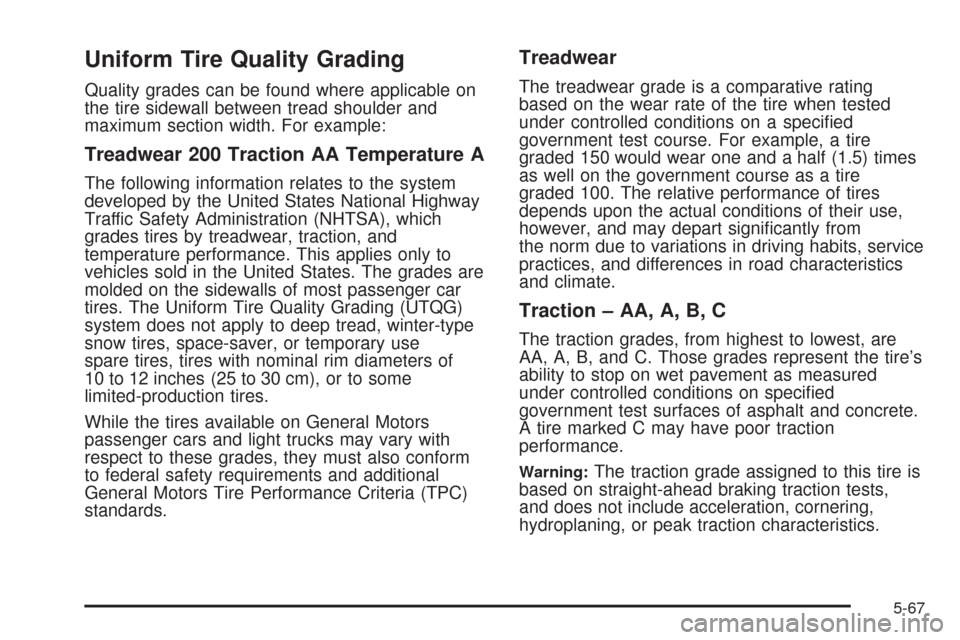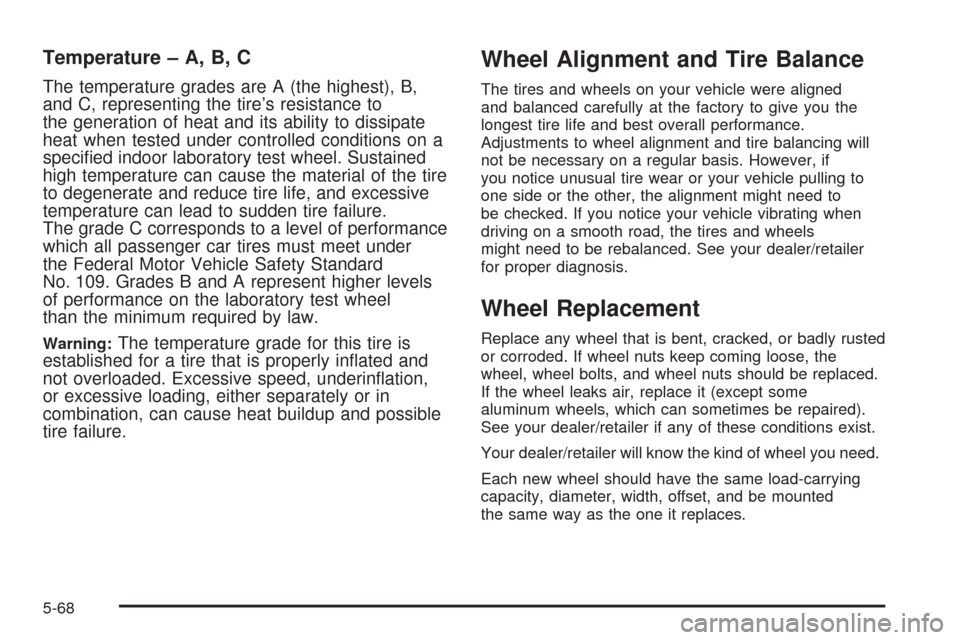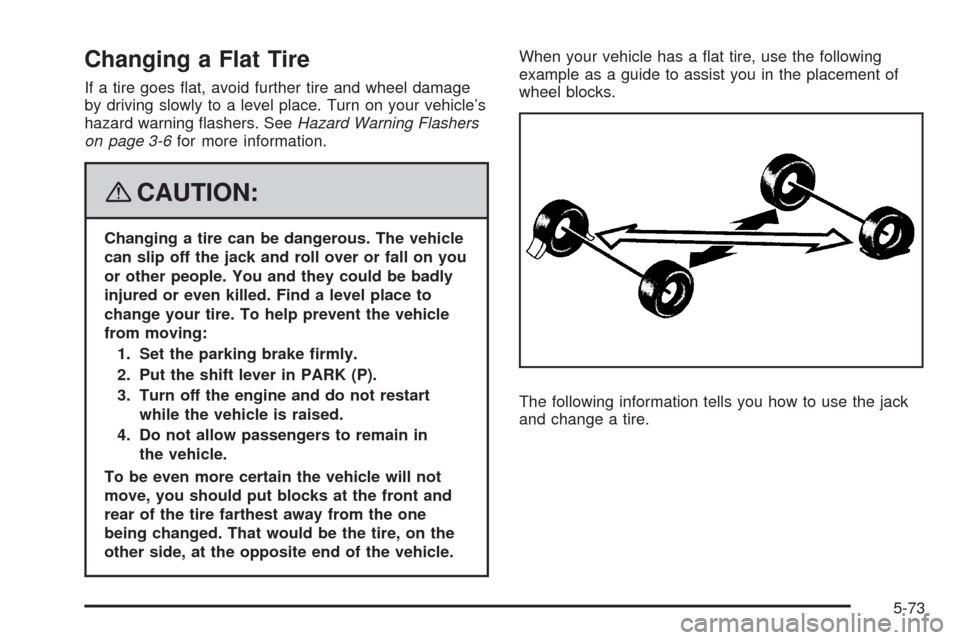2008 CHEVROLET UPLANDER warning
[x] Cancel search: warningPage 387 of 476

Uniform Tire Quality Grading
Quality grades can be found where applicable on
the tire sidewall between tread shoulder and
maximum section width. For example:
Treadwear 200 Traction AA Temperature A
The following information relates to the system
developed by the United States National Highway
Traffic Safety Administration (NHTSA), which
grades tires by treadwear, traction, and
temperature performance. This applies only to
vehicles sold in the United States. The grades are
molded on the sidewalls of most passenger car
tires. The Uniform Tire Quality Grading (UTQG)
system does not apply to deep tread, winter-type
snow tires, space-saver, or temporary use
spare tires, tires with nominal rim diameters of
10 to 12 inches (25 to 30 cm), or to some
limited-production tires.
While the tires available on General Motors
passenger cars and light trucks may vary with
respect to these grades, they must also conform
to federal safety requirements and additional
General Motors Tire Performance Criteria (TPC)
standards.
Treadwear
The treadwear grade is a comparative rating
based on the wear rate of the tire when tested
under controlled conditions on a speci�ed
government test course. For example, a tire
graded 150 would wear one and a half (1.5) times
as well on the government course as a tire
graded 100. The relative performance of tires
depends upon the actual conditions of their use,
however, and may depart signi�cantly from
the norm due to variations in driving habits, service
practices, and differences in road characteristics
and climate.
Traction – AA, A, B, C
The traction grades, from highest to lowest, are
AA, A, B, and C. Those grades represent the tire’s
ability to stop on wet pavement as measured
under controlled conditions on speci�ed
government test surfaces of asphalt and concrete.
A tire marked C may have poor traction
performance.
Warning:The traction grade assigned to this tire is
based on straight-ahead braking traction tests,
and does not include acceleration, cornering,
hydroplaning, or peak traction characteristics.
5-67
Page 388 of 476

Temperature – A, B, C
The temperature grades are A (the highest), B,
and C, representing the tire’s resistance to
the generation of heat and its ability to dissipate
heat when tested under controlled conditions on a
speci�ed indoor laboratory test wheel. Sustained
high temperature can cause the material of the tire
to degenerate and reduce tire life, and excessive
temperature can lead to sudden tire failure.
The grade C corresponds to a level of performance
which all passenger car tires must meet under
the Federal Motor Vehicle Safety Standard
No. 109. Grades B and A represent higher levels
of performance on the laboratory test wheel
than the minimum required by law.
Warning:The temperature grade for this tire is
established for a tire that is properly in�ated and
not overloaded. Excessive speed, underin�ation,
or excessive loading, either separately or in
combination, can cause heat buildup and possible
tire failure.
Wheel Alignment and Tire Balance
The tires and wheels on your vehicle were aligned
and balanced carefully at the factory to give you the
longest tire life and best overall performance.
Adjustments to wheel alignment and tire balancing will
not be necessary on a regular basis. However, if
you notice unusual tire wear or your vehicle pulling to
one side or the other, the alignment might need to
be checked. If you notice your vehicle vibrating when
driving on a smooth road, the tires and wheels
might need to be rebalanced. See your dealer/retailer
for proper diagnosis.
Wheel Replacement
Replace any wheel that is bent, cracked, or badly rusted
or corroded. If wheel nuts keep coming loose, the
wheel, wheel bolts, and wheel nuts should be replaced.
If the wheel leaks air, replace it (except some
aluminum wheels, which can sometimes be repaired).
See your dealer/retailer if any of these conditions exist.
Your dealer/retailer will know the kind of wheel you need.
Each new wheel should have the same load-carrying
capacity, diameter, width, offset, and be mounted
the same way as the one it replaces.
5-68
Page 393 of 476

Changing a Flat Tire
If a tire goes �at, avoid further tire and wheel damage
by driving slowly to a level place. Turn on your vehicle’s
hazard warning �ashers. SeeHazard Warning Flashers
on page 3-6for more information.
{CAUTION:
Changing a tire can be dangerous. The vehicle
can slip off the jack and roll over or fall on you
or other people. You and they could be badly
injured or even killed. Find a level place to
change your tire. To help prevent the vehicle
from moving:
1. Set the parking brake �rmly.
2. Put the shift lever in PARK (P).
3. Turn off the engine and do not restart
while the vehicle is raised.
4. Do not allow passengers to remain in
the vehicle.
To be even more certain the vehicle will not
move, you should put blocks at the front and
rear of the tire farthest away from the one
being changed. That would be the tire, on the
other side, at the opposite end of the vehicle.When your vehicle has a �at tire, use the following
example as a guide to assist you in the placement of
wheel blocks.
The following information tells you how to use the jack
and change a tire.
5-73
Page 463 of 476

A
Accessories and Modi�cations............................ 5-3
Adding Equipment to Your Airbag-Equipped
Vehicle.......................................................1-90
Additives, Fuel................................................. 5-6
Add-On Electrical Equipment............................5-99
Air Cleaner/Filter, Engine.................................5-18
Air Conditioning......................................3-24, 3-27
Airbag
Passenger Status Indicator...........................3-38
Readiness Light..........................................3-37
Airbag System................................................1-77
What Will You See After an Airbag In�ates?....1-84
When Should an Airbag In�ate?....................1-82
Where Are the Airbags?...............................1-80
Airbag Systems
Adding Equipment to Your Airbag-Equipped
Vehicle...................................................1-90
How Does an Airbag Restrain?......................1-83
Passenger Sensing System...........................1-85
Servicing Your Airbag-Equipped Vehicle..........1-90
What Makes an Airbag In�ate?......................1-83
Antenna, Fixed Mast......................................3-121
Antenna, XM™ Satellite Radio Antenna System . . . 3-121
Antilock Brake System (ABS)............................. 4-5
Antilock Brake, System Warning Light................3-42Appearance Care
Aluminum Wheels........................................5-95
Care of Safety Belts and Built-in Child
Restraint Harness.....................................5-93
Chemical Paint Spotting...............................5-96
Child Restraint Pad......................................5-92
Cleaning Exterior Lamps/Lenses....................5-94
Fabric/Carpet..............................................5-91
Finish Care.................................................5-94
Finish Damage............................................5-96
Instrument Panel, Vinyl, and Other Plastic
Surfaces.................................................5-92
Interior Cleaning..........................................5-90
Leather......................................................5-92
Sheet Metal Damage...................................5-96
Tires
..........................................................5-96
Underbody Maintenance...............................5-96
Vehicle Care/Appearance Materials................5-97
Washing Your Vehicle...................................5-93
Weatherstrips..............................................5-93
Windshield, Backglass, and Wiper Blades.......5-95
Appointments, Scheduling Service....................... 7-9
Audio System.................................................3-84
Audio Steering Wheel Controls....................3-119
Chime Level Adjustment.............................3-121
Fixed Mast Antenna...................................3-121
1
Page 464 of 476

Audio System (cont.)
Navigation/Radio System, see Navigation
Manual.................................................3-102
Radio Reception........................................3-120
Rear Seat Audio (RSA)...............................3-117
Setting the Time..........................................3-85
Theft-Deterrent Feature...............................3-118
XM™ Satellite Radio Antenna System...........3-121
Audio System(s).............................................3-86
Automatic Door Lock.......................................2-12
Automatic Transmission
Fluid..........................................................5-20
Operation...................................................2-35
B
Battery..........................................................5-36
Electric Power Management..........................3-20
Run-Down Protection...................................3-21
Brake
Emergencies................................................ 4-6
Brakes..........................................................5-33
System Warning Light..................................3-41
Braking........................................................... 4-4
Braking in Emergencies..................................... 4-6
Break-In, New Vehicle.....................................2-31
Bucket Seats, Rear........................................... 1-6
Built-in Child Restraint.....................................1-68Bulb Replacement...........................................5-42
Front Turn Signal, Parking and Daytime
Running Lamps........................................5-44
Halogen Bulbs............................................5-42
Headlamp Aiming........................................5-41
License Plate Lamps....................................5-46
Replacement Bulbs......................................5-46
Taillamps, Turn Signal, Stoplamps and
Back-up Lamps........................................5-44
Buying New Tires...........................................5-65
C
Calibration.....................................................3-56
California Fuel.................................................. 5-5
California Perchlorate Materials Requirements....... 5-4
California Proposition 65 Warning....................... 5-3
Canadian Owners................................................ ii
Capacities and Speci�cations..........................5-105
Captain Chairs, Rear.......................................1-14
Carbon Monoxide...........................2-41, 4-17, 4-28
Care of
Safety Belts and Built-in Child Restraint
Harness..................................................5-93
Cargo Lamp...................................................3-19
CD, MP3 .......................................................3-98
Chains, Tire...................................................5-70
Charging System Light....................................3-40
2
Page 466 of 476

Customer Assistance Information (cont.)
Reporting Safety Defects to General Motors....7-14
Reporting Safety Defects to the Canadian
Government............................................7-14
Reporting Safety Defects to the
United States Government.........................7-14
Roadside Assistance Program......................... 7-6
Service Publications Ordering Information........7-15
D
Daytime Running Lamps/Automatic Headlamp
System......................................................3-16
Defensive Driving............................................. 4-2
Delayed Lighting.............................................3-18
Delayed Locking.............................................2-12
DIC Compass.................................................3-56
Disc, MP3......................................................3-98
Doing Your Own Service Work........................... 5-4
Dome Lamp...................................................3-18
Door
Automatic Door Lock....................................2-12
Delayed Locking..........................................2-12
Dual Sliding Doors.......................................2-13
Locks........................................................2-10
Power Door Locks.......................................2-11
Power Sliding Door......................................2-16
Programmable Automatic Door Unlock............2-13Driver Information Center (DIC).........................3-50
DIC Operation and Displays..........................3-50
DIC Vehicle Personalization..........................3-76
DIC Warnings and Messages........................3-58
Driving
At Night.....................................................4-13
Before a Long Trip......................................4-15
Defensive..................................................... 4-2
Drunken....................................................... 4-3
Highway Hypnosis.......................................4-15
Hill and Mountain Roads..............................4-16
In Rain and on Wet Roads...........................4-14
Rocking Your Vehicle to Get it Out.................4-21
Winter........................................................4-17
Dual Climate Control System............................3-27
DVD
Rear Seat Entertainment System..................3-102
E
EDR .............................................................7-16
Electrical System
Add-On Equipment......................................5-99
Fuses and Circuit Breakers.........................5-100
Headlamp Wiring.........................................5-99
Instrument Panel Fuse Block.......................5-100
Power Windows and Other Power Options......5-99
Underhood Fuse Block...............................5-102
Windshield Wiper Fuses...............................5-99
4
Page 467 of 476

Engine
Air Cleaner/Filter.........................................5-18
Check and Service Engine Soon Light............3-44
Coolant......................................................5-22
Coolant Heater............................................2-34
Coolant Temperature Gage...........................3-43
Drive Belt Routing.......................................6-14
Engine Compartment Overview......................5-12
Exhaust.....................................................2-41
Oil .............................................................5-13
Oil Life System...........................................5-16
Overheated Protection Operating Mode...........5-25
Overheating................................................5-24
Running While Parked..................................2-42
Starting......................................................2-32
Entry Lighting.................................................3-18
Event Data Recorders.....................................7-16
Exit Lighting...................................................3-19
Extender, Safety Belt.......................................1-42
Exterior Lamps...............................................3-14
F
Filter
Engine Air Cleaner......................................5-18
Finish Damage...............................................5-96
Fixed Mast Antenna.......................................3-121
Flashers, Hazard Warning.................................. 3-6Flash-to-Pass................................................... 3-8
Flat Tire........................................................5-72
Flat Tire, Changing.........................................5-73
Flat Tire, Storing.............................................5-86
Fluid.............................................................5-20
Power Steering...........................................5-31
Windshield Washer......................................5-32
Folding Tray...................................................2-59
Front Console Storage Area.............................2-59
Front Reading Lamps......................................3-19
Front Turn Signal, Parking and Daytime
Running Lamps...........................................5-44
Fuel............................................................... 5-5
Additives...................................................... 5-6
California Fuel.............................................. 5-5
E85 (85% Ethanol)........................................ 5-6
Filling a Portable Fuel Container....................5-10
Filling the Tank............................................. 5-8
Fuels in Foreign Countries.............................. 5-7
Gage.........................................................3-49
Gasoline Octane........................................... 5-5
Gasoline Speci�cations.................................. 5-5
Low Warning Light.......................................3-49
Fuses
Fuses and Circuit Breakers.........................5-100
Instrument Panel Fuse Block.......................5-100
Underhood Fuse Block...............................5-102
Windshield Wiper.........................................5-99
5
Page 468 of 476

G
Gage
Engine Coolant Temperature.........................3-43
Fuel..........................................................3-49
Speedometer..............................................3-36
Tachometer.................................................3-36
Garage Door Opener.......................................2-51
Gasoline
Octane........................................................ 5-5
Speci�cations............................................... 5-5
Glove Box.....................................................2-56
GM Mobility Reimbursement Program.................. 7-6
H
Hazard Warning Flashers................................... 3-6
Head Restraints............................................... 1-6
Headlamp
Aiming.......................................................5-41
Headlamp Wiring............................................5-99
Headlamps
Bulb Replacement.......................................5-42
Daytime Running Lamps/Automatic Headlamp
System...................................................3-16
Exterior Lamps............................................3-14
Flash-to-Pass............................................... 3-8
Halogen Bulbs............................................5-42
Headlamps and Sidemarker Lamps................5-42Headlamps (cont.)
High/Low Beam Changer................................ 3-8
On Reminder..............................................3-15
Wiper Activated...........................................3-15
Headlamps and Sidemarker Lamps...................5-42
Heated Seats................................................... 1-3
Heater...................................................3-24, 3-27
Highbeam On Light.........................................3-48
High-Speed Operation, Tires.............................5-56
Highway Hypnosis...........................................4-15
Hill and Mountain Roads..................................4-16
Hood
Checking Things Under................................5-10
Release.....................................................5-11
Horn............................................................... 3-6
How to Wear Safety Belts Properly...................1-28
I
Ignition Positions.............................................2-31
Infants and Young Children, Restraints...............1-46
In�ation - Tire Pressure...................................5-54
Instrument Panel
Overview..................................................... 3-4
Instrument Panel (I/P)
Brightness..................................................3-17
Cluster.......................................................3-35
Interior Lamps
Control.......................................................3-17
6